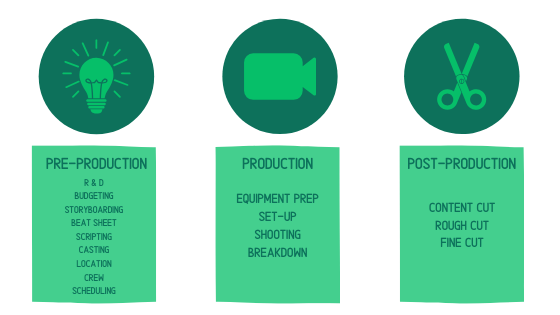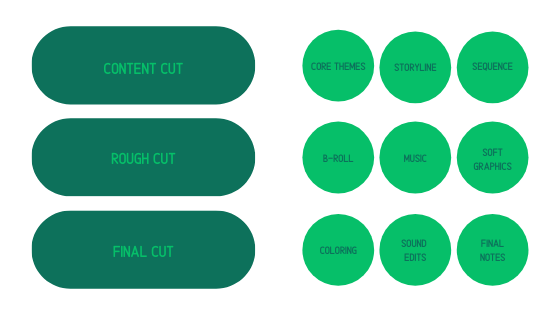No other medium has the power to demonstrate a concept and evoke a response as effectively as video. When implemented into your marketing strategy, high quality video can have a huge impact on your bottom line, elevating brand positioning and fostering customer advocacy.
This is where the importance of video production comes to play. Video of any kind is a direct representation of your brand. In other words, production quality equals brand quality, which is why you need more than just an iPhone to make a high-end video.
But what does the video production process actually look like?
In this guide we’ll cover each step in the video production process as well as the core building blocks used by successful producers.
The Three Phases of Production

Phase One: Pre-Production
Pre-production is the first step towards transforming an idea into a workable project. This phase is all about laying the groundwork to capture the best footage with the strongest story arc to deliver your message.
The planning, problem-solving, and organization that go into pre-production are essential to ensure the success of any video project.
Development
At the outset of pre-production is development. The client and producer will come together to establish what the purpose of the video is, who the target audience is, and what the core messaging and objectives for the project will be. Based on these goals, the creative team will define:

Form – what kind of video lends itself best in delivering this story, i.e. long-form documentary, motion graphics, talking head, instagram video, PSA, animated explainer etc.
Story – who are the characters or people involved? If it is a documentary or talking head, what real people can we find whose stories align with your brand message? You always want your project to lean more towards the do than the say because video is a visual medium. Show, don’t tell.
Style – what does this video look like? What are the visuals and motion graphics needed? Matching the style of the video with your company’s branding is imperative for effective messaging. Ultimately, the visual style should allow viewers to easily associate the video’s message with your brand.
Tone – what is the feeling we want the video to convey? Is it funny, sad, upbeat, etc. How does this tone align with the overall tone of the brand?
Delivery specs– what platform is this going to be distributed on? Is the video for social media? Fundraising event? Recruiting? At Green Buzz we create tailored video formatting and strategy to maximize video objectives and performance.
Defining these components early allows the production team to develop a strategy for the creative process and the actual execution of those ideas. A clear development strategy is an integral part of any effective video production process.
Research
Research is critical in finding authenticity in any story. For example, if you are shooting a documentary or interview-based video, this is the point where the producer and their team look into what players were involved when the story unfolded, who is willing to talk about what on camera, and how these interviews fit together to paint the whole story for audiences.
Background research can help inform things like daily rituals, visuals, and supporting cast which can be the details that elevate video caliber from good to great.
Budget
Budget goes hand in hand with development. Because creative freedom can be limited by the project’s price point, it is essential to define the budget early in the production process. By first establishing the financial limits, the production team can develop a video concept that is both effective and feasible.
The producer will break down what footage is needed to construct the narrative, while also organizing the best crew to make that happen. Based on the number of shoot days and team members the client can afford, the producer curates a group of technical experts to serve as the crew for the project. Skilled producers will be stewards of the client dollar, maximizing ROI without cutting corners that cheapen the project.
Storyboarding
Storyboarding is essential to outlining the visual framework of a project. Preparing the setting or mise-en-scène in pre-production is imperative for video marketing projects because it allows clients and producers to be able to visualize the same narrative all the way through the full production cycle.
Storyboarding involves both the artistic and practical sides of pre-production. StudioBinder describes storyboarding as critical in facilitating the presentation, planning, and collaboration of a video project. A storyboard resembles the format of a comic book, with characters and their actions mapped out in panels. For the director, it also informs expected camera movements and the equipment required to achieve that anticipated effect. Even if the final product isn’t an exact shot-by-shot replica of the storyboard, the process itself is important in aligning the visions of many different people and working out a framework that you’ll continue to build on throughout different iterations of the process.
Beat Sheet
No matter what kind of video you are producing, each scene has a narrative mission to add information that moves the story forward.
The beat sheet is the perfect way to reverse engineer the storyline and create a mission-driven story skeleton. The producer will work very closely with the director of photography (DP) to flesh out the visuals needed to get from point A to B in the story, while also considering how each of these points (or beats) communicate the message to the audience in the style and tone the client wants. During the shoot, the beat sheet also serves as a checklist or guide for the production team by highlighting the main points that they need to nail the narrative.
Making each scene an optimization of its mission is critical in creating rich story arcs, as it creates striking micro-moments that are compelling and memorable, and avoids delivering information for the sake of filling space.
Script Development
The producer will work with their creative team to develop a script for the project. Again, this process will be different depending on the nature and scope of the video, but the writing will focus on bringing forward the key objectives and messages of the piece.
If the video requires interviews, then this is the period where the creative team will draft careful questions to guide the storyline and hit major themes. After the scripts or interview questions have been developed and reviewed by the client, the producer moves on to casting.
Casting
Casting varies greatly based on the specifications of a particular project, with the main differences being if you are casting “pro talent” (actors) or “real talent” (real people).
Casting real talent can be tricky as there are more unknowns with people who don’t have much exposure to being on camera. However, often using real people is crucial to presenting an authentic narrative. If this is the case for the project, it’s important to work with a producer who has experience working with non-actors in video production.
Josh and Benny Safdie’s work with casting director Jennifer Venditti on their recent film, Uncut Gems, is a prime example of effective street-scouting and collaboration with real talent. Chasing after the New York diamond district, the latest film from the Safdie brothers achieves its specificity of tone and style through its casting. In our project with Upworthy and the city of New Orleans, we highlighted Chef Byron Bradley, a non-actor whose authentic connection to his community was not replicable in professional actors.
You want to look for people with the most impactful story, that are able to sell your message and represent your brand regardless of their job title or credentials. Does this person’s life have rich visuals? Do they have energy and are they articulate? Often producers will conduct preliminary video interviews with real talent to get a sense of these baseline questions. This type of talent is invaluable, but it still requires a level of skill and experience to mold each narrative into the format of a video spot that’s just a few minutes long.
Location Scouting
The producer and DP (director of photography) scout location so that they know exactly what they are walking into on shoot day. This allows the crew to be prepared to get the best shots, in the right light, with the right props, and highest sound quality.
Location scouting also allows the crew to make arrangements for unexpected details, like a lack of outlets in the shoot space, street construction, or trash that may interfere with a shot. Being able to account for these factors in advance is a major part of an effective pre-production strategy.
Crew
Working with the right crew is essential to the success of a shoot. The crew should be highly vetted, and ideally has prior experience working together on shoots.
This is one of the distinguishing factors at Green Buzz Agency, because the core of our production crew is in-house. This means that our team comes with a level of synergy and collective expertise that is difficult to match at freelancer-dependent agencies.
Each shoot will require a specific crew to make the video come to life. If you are working on a big complicated project with lots of moving parts, it is critical to have the right crew and the right number of people on set to move equipment, set up sound and lighting, get hair and makeup on the talent, and keep the production workflow running smoothly.
At the same time, if the goal of the shoot is to create an intimate interview, you will want a smaller crew on set to ensure that you are able to capture the correct tone and feel of the project.
A skilled producer will have the messaging and objectives of the project in mind when putting together the crew.
Production Schedule
Just as the name suggests, the production schedule determines who will be on camera, when they will be on camera, and at what location. It is crucial for everyone involved to have access to the production schedule. Of course, every individual team member needs to know where he or she needs to be, but knowing where to find every other person during a shoot is also of the utmost importance.
Call Sheet
Call sheets are created for each day of shooting. Every call sheet will paint a roadmap for the shoot and is intended to ensure that each task on set has been clearly defined. This process ensures that everyone involved knows exactly what to do on shoot day.
The more you can do to have everyone in agreement up front, the less confusion there is on the actual shoot. Each scene on the script will be broken down into the call sheet, which allows everyone on set to do their jobs with maximum efficiency.
Phase Two: Production
It’s finally shoot day! The meetings, brainstorming sessions, and preparations are in place and it’s time to capture the raw visuals and soundbites you need for your video.
During production, the crew will come in and set up sound, light, and video equipment to prepare for actors, interviews, voice overs, b-roll and anything else your video requires.
Think of pre-production and production as a game of dominos. Pre-production is the process of lining up all the dominos meticulously and in the right way. The more that you can plan and commit to your design up front, the more you can ensure all the pieces are perfectly in position, which reduces the chance of a misfire.
In keeping with this analogy, production is the art of knocking down the dominos and making sure they fall exactly as they’re supposed to. This might mean knocking down the dominos halfway and restarting them multiple times or making adjustments to the original alignment.
Importance of Experience
The distinguishing factor between a good crew and a great crew is the battle scars of years and years of experience.
Experienced crews have handled the spectrum of things that can go wrong on set and know how to exude confidence and make anything work, no matter the hurdles. This is why it is critical to work with a seasoned crew who can draw on the past and problem-solve on the fly.
Vetted experience often differentiates full-service agencies and a freelancer dependent companies or production houses. With an agency, you’ll get a tenured crew that is used to working together and has developed a strong synergy which increases efficiency and reduces on-set costs.
Agencies like Green Buzz with diverse client portfolios, also bring a wealth of industry knowledge, as there are few fields or categories of video that we haven’t worked with in one form or another.
Flexibility
Approaching a shoot with the mission and vision mapped out in pre-production helps the story come to life. Nevertheless, it is important not to lock a story in stone; the storyline of any video project has to be a living, breathing, flexible organism to ensure that compelling, unscripted and unexpected moments are captured on shoot day.
Prioritizing
Producers will move things around in the grand scheme of priorities with the end result in mind. As an interview is being shot, high level producers will cut through the scenes in their head and sequence the story as it is being captured.
This skill is critical, because the scariest part of production is that you have such a small window to get everything you need for your entire edit. Prioritizing by visualizing the final product throughout helps ensure that when the shoot has wrapped, you truly have everything you need for your video.
Phase Three: Post-Production
Before we jump in, one important thing to bear in mind is that post-production is a process. Videos have to be synced, footage has to be backed up and cuts are an iterative exercise.
At the early stages of pre-production, the most important thing is to get the story fleshed out so that the content and narrative are used and created effectively. For that reason, rough cuts are in fact, rough.
Then the bells and whistles are added to the project in final edits.
It’s also worth noting that even as technology grows and evolves, backing up footage and rendering still takes time. Exporting isn’t instantaneous, with a lot of technology and computing power at work to make things look as good as they do.
This is where client communication is so important. Maintaining clear and consistent communication channels allows everyone to feel like a valued member in a creative partnership throughout the entire production process.
Piecing Together the Story
After the shoot has wrapped and the footage has been backed up, the producer will get an initial pulse from the client as to what they liked or found particularly poignant in the footage.
Producers and editors will more closely analyze the film and find out how to fit the pieces of the puzzle together to form the larger story.
Each producer will have their own approach to the process. One of our in-house producers likes to start with a paper cut, where she watches the footage with a transcript in hand and literally cuts different parts of the copy and puts it on her wall so that she can rearrange the text in ways that create the most compelling story.
Editors, Designers & Cuts
Skilled editors are their own story producers, and have honed the craft of pulling footage and b-roll together to create a rich and immersive narrative. The project will go through several post-production phases, or cuts, to get to its final polished form:

Content Cut – Alongside the producers, editors will comb through everything that was shot and pull selects that build core themes and storylines. After the core content bites are collected, they’re put into sequence, creating a skeletal of the entire video.
Rough Cut – The rough cut has general b-roll, music and soft graphics and is usually still theoretical in form. At Green Buzz, our rough cuts are tight, and cutting-edge because they tend to look closer to a fine cut than a rough cut. The client will review the rough cut and provide their notes and feedback. Tackling projects up front means we’re able to incorporate client modifications earlier in the process, which shapes the final version with maximum client collaboration.
Fine Cut – The fine cut will include color correction, graphics, music and sound as well as an incorporation of all the client notes from the rough cut phase. Final bells and whistles like subtitles and formatting for social will also be added during this last phase of the project.
Final take-aways
Ultimately, the production process is highly individualized and scalable based on the project that you want to create. Still, every video will require in-depth research and planning during pre-production, a highly knowledgeable crew with the right equipment during production, and innovative editors and designers who can weave a rich story arc together for the final cut.
Amelia Oliver, Marketing Strategist. Emily Herman contributed to this post.
